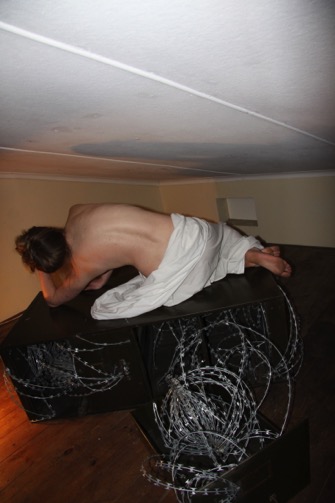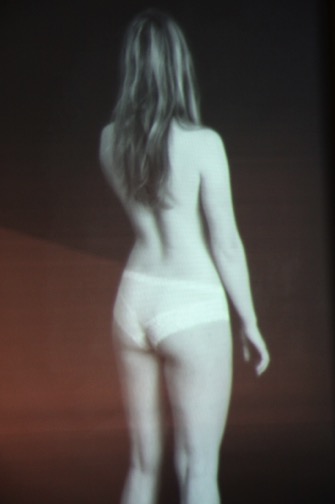Excerpt from “Between a cushion and a risky conversation” by Rachel Baasch (De Arte 48, 2011)
“A large metal filing cabinet found in the upstairs room of the ARTS LOUNGE premises (known as ‘the attic’) became a living, breathing reference to a history of the reclining female nude in Western art discourse. From the bottom of the stairs the lyrics of Frank Sinatra’s version of My Funny Valentine could be heard playing in the upstairs attic. In the room leading into the attic was a video projection by Mark Wilby of Lucy Kruger (a participating Drama student), as she moved in a slow circle, semi-naked, a knife in one hand, singing the words to My Funny Valentine. The sound was muted on the video, but played in sync with the projected image. With her back to the audience, the nude – the ‘living’ Kruger – moved with a tense, painful and awkward slowness as she reclined on top of the festering razor-wire container in the attic.
Athina Vahla choreographed the piece in such a way that it is primarily Kruger’s back which moves, a slow ‘dance’ focused on one part of her body, each muscle distinguishing itself from the next, each bead of sweat, each shake, tremble or strain is magnified. In ‘the attic’ Kruger’s back was turned to her small crowd of spectators. In the room leading into the miniature space, Mark Wilby’s video piece of the same performer was the reverse of
this. The virtual Kruger was standing upright, facing the viewer at the start and end of
every revolution, staring out at her imaginary audience, as they gazed at her real form in ‘the attic’.
The discomfort of this performance (Nude on Cabinet) does not necessarily lie with the potentially erotic, sexualised use of a naked woman’s body, or the relationship between her exposed flesh and the loops of razor wire nests creeping up the edges of her cold cabinet recliner. It can be argued that the unease of the piece has to do with the raw, intimate and vulnerable distance between performer and audience. The use of the attic enforces this intimacy. It is impossible to see the performance without actually entering the tiny angled room (the attic) – a cramped space shared with the camera operator, a photographer and no more than ten or twelve additional spectators at any given time during the performance. In a space as small as this there is a sense of risk not only for the performer, but also for the observer (the audience). The observer has no guidelines, no anonymity, no ‘unwritten’ rules about how to ‘look’ or how to behave within the space – there is no place to hide”.
Photos: Ruth Simbao (please do not use without copyright permission)
Text: Rachel Baasch
Funding was received from the National Arts Festival and the Visual and Performing Arts of Africa focus area


